The Thompson Turkey: A Thanksgiving Cult Classic
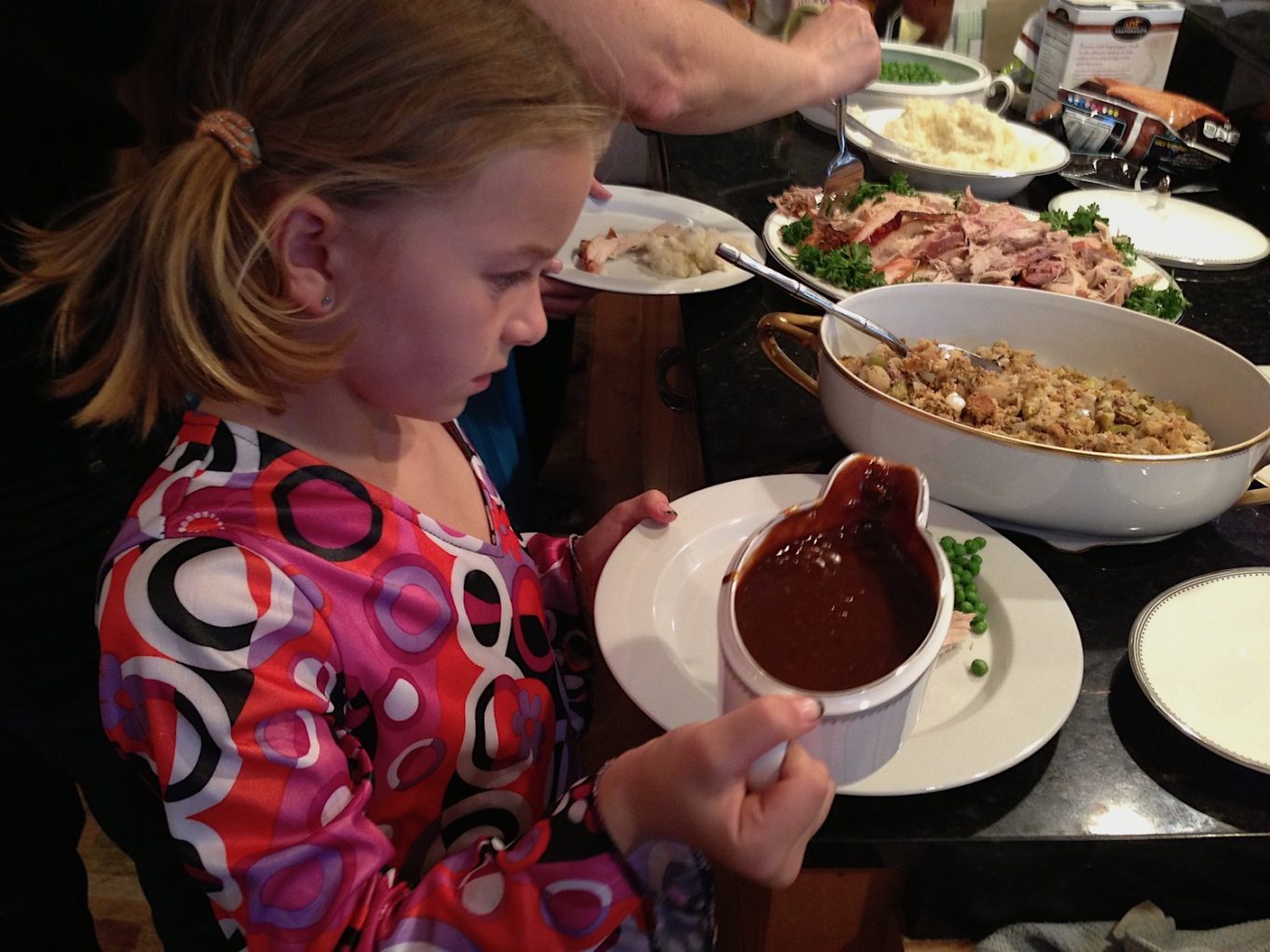
By Erika Lenkert
Apparently, I’m part of a cult.
Not a cult that would raise eyebrows with the law or force me to break from mainstream society, but a cult nonetheless. Its members are widespread and fiercely loyal and we are all devout followers. Our idol? The Thompson Turkey recipe.
I unwittingly became a worshiper as a young child. As the story goes, my mother, a serious cook and food lover, found the recipe, by American writer Morton Thompson in the 1950s, in the newspaper and started making it. (It again surfaced in Richard Gehman’s 1966 cookbook, The Haphazard Gourmet, and in Jeffery Steingarten’s 1998 The Man Who Ate Everything, the latter of which made me aware that the recipe even had a following.)
Mom was first attracted to the format of the thing; it was written in prose and included helpful tips, like “Have a drink, for God’s sake!” This instruction was a wise prelude to preparing the stuffing.
Some people may think the allure of the Thompson Turkey is the paste you coat the turkey with the second it goes in the oven. It’s made of egg yolk, onion juice, powdered mustard, and flour (I use GF). It seals in the juices while the bird cooks. (It also it turns into a hard, volcanic-black crust, which instantly makes whoever cooks it feel like a turkey anarchist.) Yes, the meat is wonderfully moist and never dries out, even days after it’s cooked. But the real reward is the stuffing (and the gravy, but I’ll get to that in a minute).
The stuffing contains about 30 ingredients, mostly of which are common spices. (I leave out the candied ginger, because it’s not my thing, and I make my own cornbread stuffing by cooking GF cornbread, cubing it, and toasting it in a low-heat oven until it’s somewhat crouton-like.) It’s so astoundingly good and one-of-a-kind, it inspires everyone at the dinner table to pause for an unplanned moment of silence out of respect and adoration. It also ensures requests for second and thirds.
Then there’s the gravy. It’s crafted from turkey drippings intermingled with a basting liquid made from a simmering mixture of the turkey’s giblets and liver, garlic, bay leaf, water, and apple cider. A small amount of the liquid is poured over the bird every 15 minutes during cooking. After hours in the oven, it reduces on the bottom of the pan to a dark, wildly tangy-savory sauce that is ultimately skimmed of some of the fat and thickened (for me with a GF flour blend) to become the gravy of all gravies.
Each year, I serve the turkey, stuffing, and gravy with classic mashed potatoes, a bowl of green peas, cranberry sauce, plus a salad and whatever guests ante up. Whenever someone new joins the dinner, I know I’ll have a new recruit by night’s end; it only takes one taste of the Thompson Turkey to become a convert.
Following is the recipe my family has followed since the 1970s. Don’t say I didn’t warn you.
Want to read more about my mom and my Thompson Turkey love affair? See the article I wrote about it for the San Francisco Chronicle in 2001.
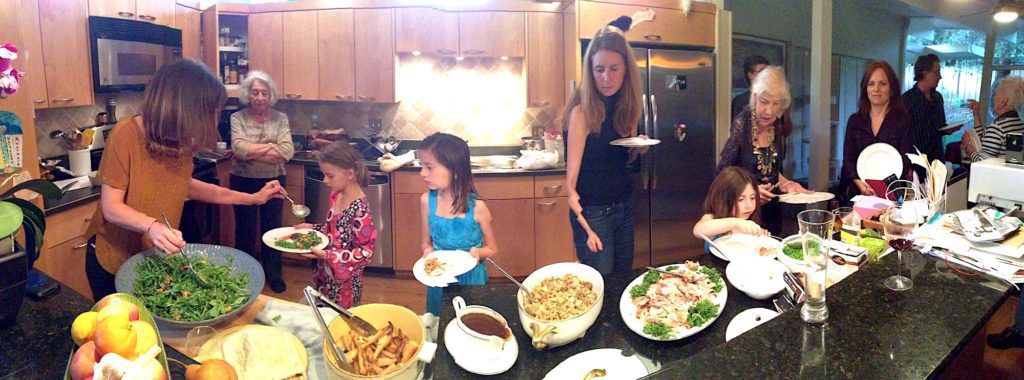
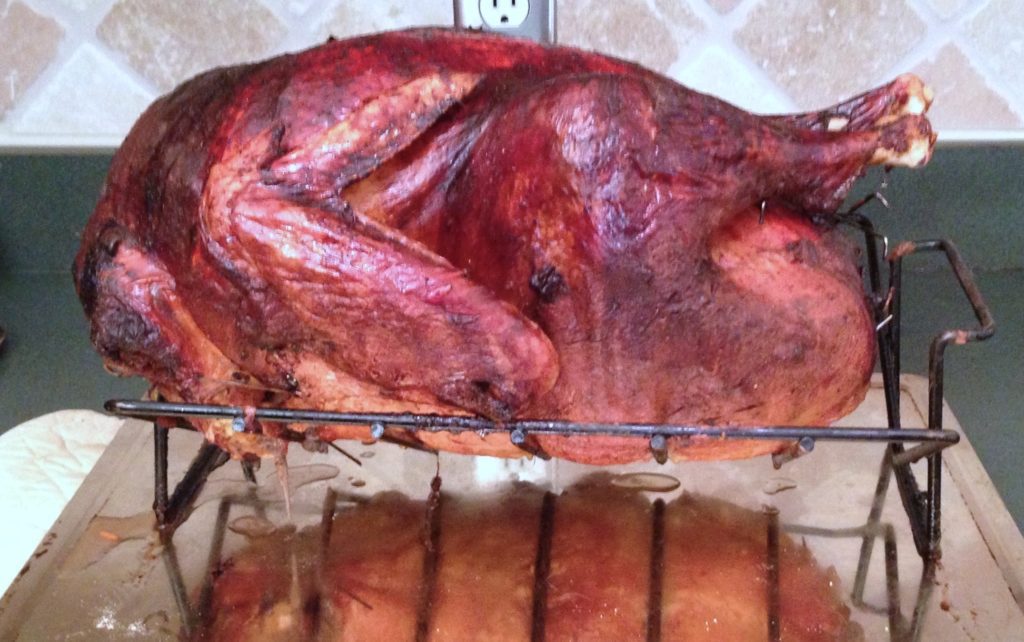
Thompson’s Turkey Made Gluten Free
I think Thompson Turkey recipe author Morton Thompson was smart to pen this recipe in prose. Looking at the ingredients in list form is enough to make anyone laugh out loud–and then run the other direction. But to be deterred would be to miss out on one of life's greatest food experiences. If you're hosting Thanksgiving, you're going to spend the day in the kitchen anyway. Why not spend your time crafting the meal of a lifetime? This, my version, makes the fabulous feast gluten-free. Bonus: This recipe includes not-to-be-missed gravy.
Ingredients
For the Turkey
- 1 (16-22 pound) turkey with giblets
- Salt and freshly ground pepper
- 1 large bay leaf
- 1 clove garlic minced
- 1 teaspoon paprika
- 1/2 teaspoon ground coriander
- 4 cups apple cider
For the Stuffing
- 1 Granny Smith apple cored, unpeeled, diced
- 1 medium orange peeled, diced
- 1 (20-ounce) can crushed pineapple undrained
- Rind of 1 lemon grated or minced
- 3 tablespoons chopped preserved ginger (I skip this)
- 2 (8-ounce) cans water chestnuts sliced, drained
- 6 ribs celery diced
- 5 cloves garlic minced
- 4 large onions diced
- 4 whole cloves crushed
- 1 red or green bell pepper seeded, chopped
- 1 large bay leaf crushed
- 1/4 cup minced fresh parsley
- 1 tablespoon celery seed
- 1 tablespoon poultry seasoning
- 2-1/2 teaspoons dried oregano chopped
- 2 teaspoons hot dry mustard Coleman’s
- 2 teaspoons caraway seeds
- 2 teaspoons poppy seeds
- 1-1/2 teaspoons sesame seeds
- 1 teaspoon freshly ground black pepper
- 2 teaspoons salt
- 1/2 teaspoon mace
- 1/2 teaspoon turmeric
- 1/2 teaspoon dried marjoram
- 1/2 teaspoon dried summer savory
- 2 dashes hot red pepper sauce
- 5 cups unseasoned gluten-free stuffing (I make my own crouton-like cornbread stuffing by making cornbread, cubing it, and baking the cubes until firm at a low temperature; find our favorite GF cornbread mixes here)
- 1 pound ground pork
- 1 stick (8 tablespoons) butter softened
For the Paste
- 8 egg yolks
- 3 cloves garlic crushed
- 1 tablespoon hot dry mustard
- 1 tablespoon onion juice
- 1 teaspoon salt
- 1/4 teaspoon cayenne pepper
- 1/3 to 1/2 cup gluten-free flour blend
For the Gravy
- 1 quart gluten-free chicken broth
- Gluten-free flour mix (enough to make a paste to thicken the gravy, perhaps 1/2 cup or less)
Instructions
-
Trim fat from inside the turkey opening; mince the fat. Place in saucepan with 1/2 cup of the water; heat to a boil. Cook until water has evaporated, about 5 minutes; set aside.
-
Prep the turkey: Rub turkey inside and out with salt and pepper. Open the packet of giblets that come inside the turkey. Set the liver aside and chop the gizzard, neck and heart. In a saucepan, combine the chopped innards with 5 cups water and the bay leaf, garlic, paprika, 1 teaspoon salt, and the coriander. This is your bastiing liquid; keep it just below a simmer, uncovered.
-
Prepare the stuffing: In a large bowl, combine apple, orange, pineapple, lemon rind, ginger and water chestnuts; set aside.
-
In another bowl, mix together the celery, garlic, onions, cloves, bell pepper, bay leaf, parsley, celery seed, poultry seasoning, oregano, dry mustard, caraway seeds, poppy seeds, sesame seeds, black pepper, salt, mace, turmeric, marjoram, summer savory, and hot red pepper sauce in another bowl.
-
In a third, large bowl, combine the breadcrumbs, pork, butter, and reserved turkey fat; mix well.
-
Add contents of the other two bowls; mix well.
-
Heat oven to 500°F. Lightly fill the turkey body and neck cavities with stuffing. Skewer and tie the opening closed with butcher string.
-
Grease a large casserole dish, then press the remaining stuffing into it. Cover, refrigerate, and bake later, when the turkey comes out, at 325°F, until it registers 165°F on a thermometer, about 1 hour.
-
Place the turkey, breast-side down, on rack in large roasting pan. Roast in the hot oven for 15 minutes. Remove, turn breast-side up, and roast 15 minutes more.
-
Meanwhile make the paste: combine the egg yolks, garlic, mustard, onion juice, salt and cayenne pepper. Add enough of the flour to make a thick paste (think pancake batter thick).
-
Turn down the oven to 325°F. Paint the turkey all over with the paste, using a basting brush. Return the turkey to oven until the paste sets, about 5 minutes. Then paint again and return to oven. Repeat this painting every 5 minutes, adding water to the paste as necessary to keep from drying out, until paste is used up.
-
Meanwhile, to the simmering basting liquid, add the reserved turkey liver and 1 cup of the apple cider. Cook until liver is no longer pink, about 30 minutes; remove and reserve the liver. Keep the liquid on simmer.
-
Continue to roast turkey, generously basting every 15 minutes (baste using a turkey baster, using about 6 tablespoons each time), adding more if necessary to ensure the bottom of the roasting pan doesn't get dry; add equal parts water and apple cider to the basting liquid as needed to keep it from depleating. Roast until a meat thermometer reads 180°F, 170°F in the breast, about 4 hours.
-
Remove the turkey and rack from the roasting pan, reserving the pan and its contents. Let the turkey stand at room temperature 30 minutes. (Don’t forget to cook the remaining stuffing, covered, the second you take the turkey from the oven.) Using tweezers or whatever you have, remove and discard the blackened paste coating from turkey.
-
Meanwhile, make the gravy: skim as much of the fat off the top of the pan drippings in the roasting pan to a bowl. In another bowl, mix 3 tablespoons of the fat with enough GF flour to make a thick paste. Heat the remaining pan drippings/reduced basting liquid in the roasting pan on the stovetop; it should be hot and barely simmering but not boiling. Chop the reserved liver into small pieces. Slowly whisk the flour paste into the drippings to thicken the gravy, whisking until it;s smooth. Whisk in the chopped liver. If there isn’t a lot of gravy or it’s too richly flavored, whisk in some chicken broth—and more flour/fat combo if needed—until you have the consistency and flavor you want.
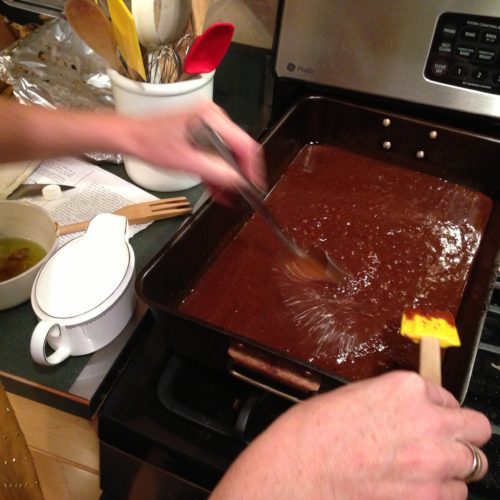
-
To serve, remove the stuffing to a serving bowl, carve turkey and plate the turkey, and serve with gravy.
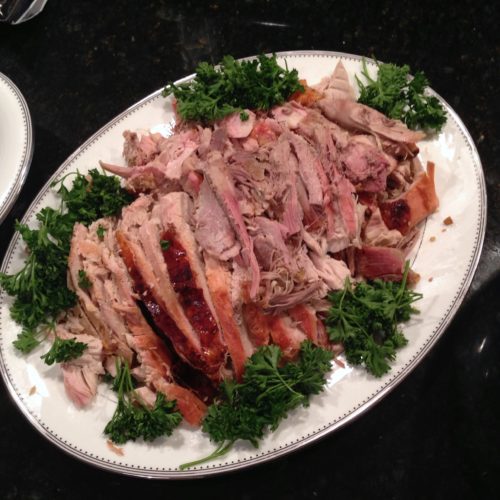


4 Comments on “The Thompson Turkey: A Thanksgiving Cult Classic”
I first made this in 1960 from the Berkeley Gazette. Hope to in my lifetime again. Great experience and delicious!
WOW! That’s amazing. I didn’t sink my teeth into it until the ’70s!
I made this for a friend and his family in the late 1960s. He went crazy thinking I was ruining his Thanksgiving dinner. I kept saying, “It needs to get darker!”. When I chipped the black stuff off there was a nicely browned and juicy bird below. Good day for food and a prank.
Hooray! I love that you made it. I enjoy it so much every year!